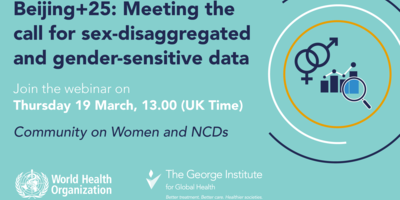
Meeting the call for sex- and gender-disaggregated data for the benefit of both women and men globally
The George Institute, in collaboration with the WHO’s Global Coordination Mechanism on NCDs, hosted a webinar on 19 March 2020 with the goal of improving sex- and gender-disaggregated collection, analysis, and reporting of health data worldwide, through shared knowledge and resources.
While recent popular literature and media, such as Carolina Criado Perez’s 2019 bestseller “Invisible Women,” have helped shift the idea that men and women have different health needs into the mainstream, and that the data needed to explain such differences are lacking, public health experts and women’s rights advocates have been calling for health systems to improve their sex- and gender-sensitive data collection and reporting for decades.
In 1995, world leaders, activists, and experts gathered in China for the Fourth World Conference on Women, and developed the Beijing Declaration and Platform for Action, which outlines targets for improving women’s rights globally. The Beijing Platform calls for increased collection, use, and management of sex-disaggregated and gender-sensitive data and recognises the importance of such data as critical to the effort to improve women’s health.
This year, experts and activists globally are marking the 25th anniversary of this Declaration and Platform by assessing progress thus far towards meeting its objectives. We organised this webinar to participate in these conversations, and in response to preliminary findings that countries around the world are lagging in their production of such data and thus in their ability to provide gender-equitable health care.
The webinar featured presentations from global experts, including colleagues Drs. Kim Quimby (The University of the West Indies) and Natasha Sobers (The University of the West Indies and the Barbados National Registry for Non-communicable Diseases); colleagues Isabel Yordi Aguirre, Dr. Brett Craig, and Dr. Ivo Rakovac (WHO Regional Office for Europe); and Dr. Sanne Peters (The George Institute and Utrecht University). Albert Motivans (Equal Measures 2030) moderated the event.
Their presentations highlighted the power of sex and gender-disaggregated data to: reveal groups most at risk of poor health; reduce biases in health services, and create interventions that can help level gender disparities in disease risk.
For example, Dr. Sobers conducted a meta-analysis to evaluate female sex as a risk factor for diabetes using studies from across the Caribbean. With these findings in hand, Dr. Quimby and her team designed a pilot intervention in Barbados that used a low-calorie diet to promote pre-diabetes and type-2 diabetes reversal in the context of faith-based organizations.
“We chose faith-based organizations […] because these were already integrated into the surrounding communities, because of their function as a community disaster shelter during the island’s hurricanes months,” explained Dr. Quimby. “There was also an average membership of more than 70% women within the churches, so that answered our questions about where we can find the women.”
This approach worked—the team successfully recruited mostly female subjects as well as predominantly female health care volunteers to administer the intervention. While participant numbers were small, the study results were very encouraging: 46% of pre-diabetes women were in remission by the end of the 12-month study period, and 89% of diabetic women had a haemoglobin A1C level of <7, indicating good diabetic control. Drs. Quimby and Sobers are confident that this model can be scaled by continuing to embed it in churches and other community centres where women congregate, showing that an understanding of female gendered behaviours will be instrumental to the intervention’s continued success.
Notably, while we often talk about the importance of disaggregating data by sex and designing gendered interventions in the context of women’s health equity, men also benefit from these approaches. For example, in outlining the WHO STEPS study, Ms. Yordi-Aguirre showed that Eastern European men were less likely than women to access health care, and less likely to receive testing for risk factors or medical guidance around lifestyle modifications that help prevent and manage NCDs.
Ms. Yordi-Aguirre commented: “[This analysis] presented nuances that in some cases led to the reconsideration of [existing] policies because they were not targeting the right groups,” so illustrating how disaggregated data can be critical to informing policy that reduces gendered barriers to care.
The webinar also contained concrete guidance on when and how to conduct sex and gender analyses (Tables 1 and 2) and how to report sex and gender-disaggregated analyses in academic publications (see the SAGER guidelines). The panellists also discussed the particular challenges of analysing data by gender, which refers to the behavioural characteristics closely linked to biological sex, as opposed to the typical male/female sex binary. Dr. Peters explained that gender scores or scales can be used to define the gender variable (this paper exemplifies this approach), and Dr. Rosemary Morgan, an audience participant from Johns Hopkins University, suggested creating gender variables based on power relations (for example, differences in resources, autonomy, and decision-making). Ms. Yordi-Aguirre cautioned that in some contexts, defining gender beyond the usual sex binary may be poorly received. “[In] many of the countries where we are working there is a huge backlash using different political agendas to go against the gender analysis and gender equality. We have to be very conscious that we’re dealing with a scientific challenge and a political challenge.”
Collectively, these presentations highlighted the importance of designing studies that take the specific gendered needs of men and women into account, and collecting and analysing data in such a way that they unveil gendered differences in NCD risks, care pathways, and outcomes. Moreover, these presentations provide examples of how this evidence can be translated into interventions and policies that take into account gendered behaviours, which in turn can improve their relevance and acceptance in the communities they are intended to support. A sex- and gender-sensitive approach to data therefore has the potential to end suffering and save lives for billions of women--AND men--globally.
- To watch the recording of the webinar and access related resources, including the webinar Q&A, please visit this page on our website.
| CONSIDER EXAMINING SEX AND GENDER DIFFERENCES IN: |
|---|
| Disease occurrence and survival |
| Disease presentation |
| Risk awareness |
| Health behaviours |
| Risk factor associations and disease mechanisms |
| Treatment and care provided |
| Safety and effectiveness of a policy or intervention |
| HOW TO ASSESS FOR SEX DIFFERENCES IN HEALTH RESEARCH |
|---|
| Consider whether sex and/or gender is relevant to the research. |
| Wherever relevant, routinely provide sex- and gender-disaggregated results. |
| Given that men and women have quite different life expectancies, always adjust by age. |
| Examine the difference on relative and absolute scales. |
| For meta-analyses examining sex differences, only include studies that report results from both male and female subjects, rather than in just one sex or the other, to reduce heterogeneity. |


